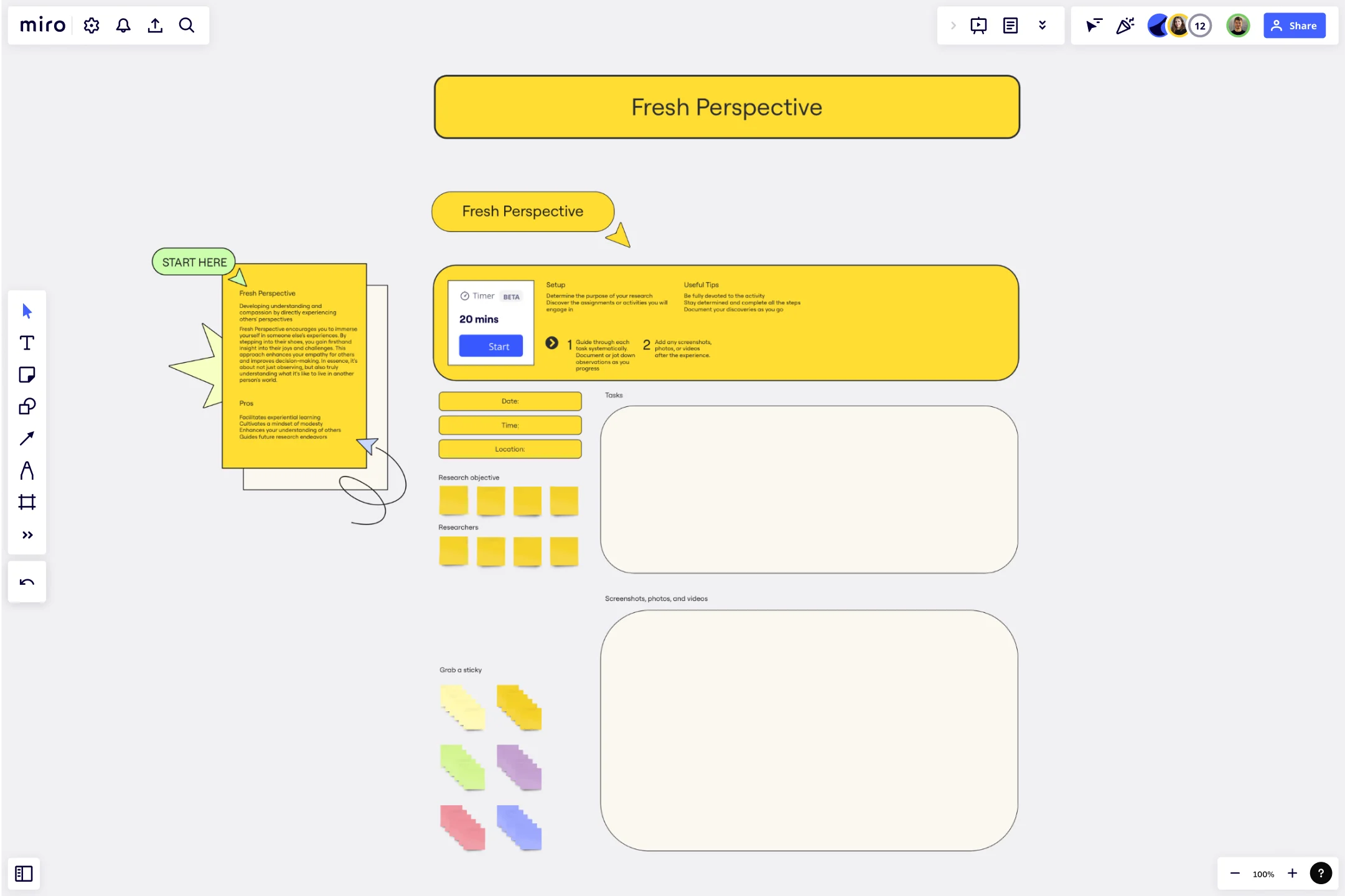Fresh Perspective Template
Develop understanding and compassion by directly experiencing others' perspectives with the Fresh Perspective Template.
About the Fresh Perspective Template
The Fresh Perspective Template encourages you to immerse yourself in someone else's experiences. You gain firsthand insight into their joys and challenges by stepping into their shoes. This approach enhances your empathy for others and improves decision-making.
In essence, it's about not just observing but also truly understanding what it's like to live in another person's world.
Benefits of using the Fresh Perspective Template
Facilitate experiential learning.
Cultivate a mindset of modesty.
Enhance your understanding of others.
Guide future research endeavors.
How to use the template in Miro
Guide through each task systematically. Document or jot down observations as you progress.
Add any screenshots, photos, or videos after the experience.
Setup
Determine the purpose of your research.
Discover the assignments or activities you will engage in.
Useful tips
Be fully devoted to the activity.
Stay determined and complete all the steps.
Document your discoveries as you go.
Get started with this template right now.
Tell a Great Story
Works best for:
Storyboard
Tell a great story with the Storyboard template. Visualize your narrative using images, notes, and descriptions to map out each scene. This template is perfect for filmmakers, content creators, and marketers looking to craft compelling stories. It helps you organize your thoughts, sequence your story elements, and ensure a cohesive flow. Whether you're planning a video, a marketing campaign, or a presentation, this tool makes storytelling easier and more effective.
Proto Persona Template
Works best for:
UX, UX Research, Product Design
The Proto Persona Template is tailored to capture the essence of hypothetical user segments. It encapsulates key attributes such as user needs, behaviors, and potential pain points. One of its standout benefits is its ability to foster empathy. By visualizing and understanding these preliminary user profiles, design and strategy teams can tap into a deeper connection with their target audience, ensuring that solutions resonate authentically and address genuine needs.
Stakeholder Empathy Map by IASA
Works best for:
Market Research, Research & Design
Stakeholder Empathy Map Template is designed to understand the perspectives of stakeholders. It helps you capture their needs, concerns, and motivations, ensuring your projects align with stakeholder expectations and foster better collaboration.
Empathy Map [Research]
Works best for:
Market Research, Research & Design
Empathy Map Research template helps you gather in-depth user insights. It’s designed for teams who want to understand user behaviors and needs better. Use this template to inform your design decisions and create user-centered products.
Buy a Feature Template
Works best for:
UX, Design, Product
The Buy a Feature Template reveals the actual significance people attach to certain aspects, creating tension by presenting options that exceed available resources. The resulting decisions provide valuable insights into which features, concepts or initiatives should be prioritized in the future.
Empathy Map by Voltage Control
Works best for:
Market Research, Research & Design
Empathy Map 1-2 captures detailed user insights by focusing on their thoughts, feelings, and behaviors. This template helps you create user-centered products by ensuring you understand and address the real needs of your users.
